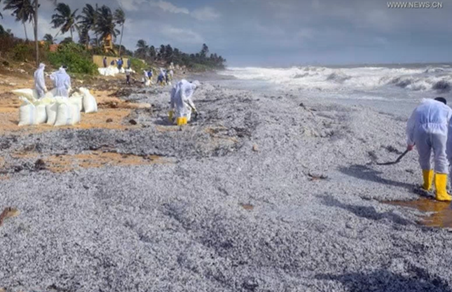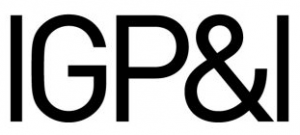The IMO Pollution Prevention and Response Sub-Committee (PPR) will meet on 4-8 April. Proposals to regulate the carriage of pre-production plastic pellets, so called “nurdles”, are on the agenda. Our authors discuss the cause and effect of nurdle spills and the specifics of the proposals on the agenda before the PPR. For additional insight into the environmental impact of nurdle pollution, we consulted GRID-Arendal, a non-profit environmental communications centre collaborating with the United Nations Environment Programme.

Marine plastic pollution - are nurdles a special case for regulation?
Published 03 April 2022
What are nurdles?
Pre-production plastic pellets or “nurdles” are about the size and shape of a lentil and are the building blocks of nearly all plastic products. Nurdles are made up of thermoplastics – various polymers that can be melted and then molded or extruded to form products ranging from grocery bags and soda bottles to the rigid pipes used in sewer systems. Most nurdles are clear or milky but they are also made in various colours. According to the OSPAR 2018 report, the EU produces between 58-70 million metric tons of nurdles per year.
How do nurdles reach the marine environment?
Nurdles are produced by petrochemical companies from oil and gas and transported by truck, rail and container vessels to the manufacturers of the end product. Pellet losses and leakage into the environment can take place at any point from the manufacturing site to the end-user. Due to their small size and buoyancy, pellets lost on land find their way to the ocean mainly through runoff. In one study of one production facility in Sweden, it was estimated that between 3 million and 36 million pellets entered the environment annually.
Transportation by sea is within containers. Nurdles may be packaged in 25 kilo plastic bags stacked and wrapped on pallets. One 25 kilo bag contains about 1 million nurdles. A full container load of nurdles would be about 1 billion nurdles. To reduce the amount of plastic used in transporting the nurdles and to increase the volume per container, manufacturers may also blow nurdles into a single heavy plastic liner filling the container. If loaded this way, the container is tipped in a secure location and emptied at destination.
As is the case with plastic litter in general, most of the nurdles found in the marine environment originate from land sources. The OSPAR 2018 report notes that annual nurdle losses in Europe are between 16,888 MT and 167,431 MT. Of this total, shipping is estimated to contribute 141-225 MT with the biggest sources of losses coming from producers, intermediary facilities and converters/processors.
Nurdles can be released from container or ro-ro ships when the container is damaged or lost overboard or, due to severe marine casualties where the ship itself is lost. Nurdles released due to marine casualties can be dramatic involving billions of pellets in one release. It is this type of spill that is the focus of this article.
Nurdles, once released, disperse widely
In 2017, two containers of high-density polyethylene (HDPE) and low-density polyethylene (LDPE) were lost overboard in the Port of Durban, South Africa. Carried by wind and currents, the estimated 50 metric tons of nurdles spread over 200 km of coastline. The clean-up took about three years.
In 2020 polypropylene (PP) nurdles spilled from a single damaged container aboard the ro-ro vessel Trans Carrier affecting to varying degrees about 1,000 km of the coastline in Norway and Sweden. Clean-up took more than a year. Later in 2020, – 6 containers of low-density polyethylene (LDPE) nurdles were lost off Cape Agulhas in South Africa. Dispersed in the strong Agulhas current, the nurdles affected some 1,600 km of coastline. Clean-up is on-going.
By far the worst nurdle spill occurred in May 2021 off Colombo Sri Lanka after the X-Press Pearl caught fire and partially sank. The vessel was coming from India to Sri Lanka with 1,377 containers on board, 422 of which contained nurdles of various polymers. The nurdles, included burnt and melted nurdles dispersed over 300 kilometers of the Sri Lanka coastline. The clean-up is on-going with the high concentrations removed.


* Condition of Sarakkuwa Beach, Sri Lanka, before and after bulk nurdle recovery. Further shoreline clean-up is still on-going in this location, as of 31 March 2022. Photo credits- Gayan Sameera/Xinhua and ITOPF*
Highly concentrated areas can be cleaned relatively easily, however removing all ship-related nurdle contamination is extremely difficult. Due to their small size and buoyancy, nurdles are highly mobile and heavily influenced by tides, waves and wind. Nurdles readily mix with shoreline sediments, as well as becoming trapped between rocks and within vegetation, only to be remobilized during subsequent tides and extreme weather events months to years after the original spill.
Recent cases have demonstrated that responses to nurdles spills are laborious and extremely protracted. The highly mobile nature of nurdles results in large areas of coastline being affected. Moreover, the lack of sophisticated mechanical recovery methods results in the response relying heavily on a large workforce and rudimentary manual clean-up methods, such as sieving and water separation.
According to the international spill respond organisation, ITOPF, it is generally accepted by stakeholders that recovering all ship-related nurdles is impossible. The rate of recovery varies by case, but depends highly on, among other things, the location of the incident, the access to contaminated shoreline, the shoreline type, the level of pre-existing plastic contamination and, ultimately, the specific response end-points. During recent cases, between 40 – 70% of spilt nurdles have been recovered.
Environmental impact of nurdles
Once in the ocean, due to their mostly low density, pellets float on the surface, allowing them to spread over large areas by wind and currents. Some pellets will wash up on beaches, others will continue to circulate in ocean currents. Over time, at beaches or in the water, due to UV and abrasion, pellets will eventually wear down into smaller particles whose hazards are even more complex. A baseline study of microplastics in the Northeast Atlantic showed that pellets represented about 10% of the most abundant types found. The impacts are wide, the main ones being ingestion, leaching of additives and acting as vectors for persistent organic pollutants, microbes and invasive (micro)organisms. Some marine biota, such as seabirds, fishes, marine mammals, and other species, confuse plastic pellets with food. Several reports have shown the presence of pellets within digestive systems of these animals, potentially leading to serious health implications. These effects are generally caused by physical damage, e.g. inflammatory responses, as well as reduced feeding behaviour when microplastics are consumed instead of digestible food.
Plastic pellets can also leach additives, chemicals added during production. Plastic additives provide required properties to a plastic polymer or are incorporated to facilitate the manufacturing process, e.g. colourants, stabilisers, softeners. Recent studies demonstrated, using leaching experiments, that various plastic additives are toxic to a wide range of organisms, e.g. carcinogenic; causing neurological damage; disturbing hormone systems, metabolic or reproduction processes. Furthermore, plastic pellets, depending on the circumstances, also accumulate toxic substances present in surrounding media such as persistent organic pollutants and metals on their surfaces. These loaded nurdles could thus become both a transport medium and a source of toxic chemicals in the environment. This has even led to the use of pellets for the global monitoring of POPs by using beached plastic resin pellets (International Pellet Watch | Global Monitoring of POPs using Beached Plastic Resin Pellets.) Pellets can transport and spread harmful organisms including pathogenic bacteria and viruses attached to the surface. Finally, biological material can become attached to pellets, forming an ecocorona, affecting their density which might lead them to sink more rapidly where they affect different organisms.
The regulatory landscape and proposals before the IMO
There is no international regulation specific to the carriage of nurdles or nurdle pollution. In March 2022, the United Nations with the support of 173 nations adopted a resolution to create an international treaty aimed at restricting the explosive growth of plastic pollution including microplastics. Among other objectives, the treaty is intended to promote national and international cooperative measures to reduce plastic pollution in the marine environment. The target date for completion of a draft is 2024 and the negotiations on content have yet to begin.
The Nairobi International Convention on removal of wrecks, 2007 which came into force in 2015 requires that sunken or stranded vessels and any object that is or has been aboard the ship to be removed if the vessel or object threatens the marine environment or damage to the coastline or related interests of one or more states. Related interests include fisheries and tourist industries. Registered owners are required to have insurance that covers the cost of removal. The International Group of P&I Clubs, which insures more than 90% of ocean-going tonnage, provides insurance cover for wreck removal. The Nairobi Convention applies to both containers and cargo that are aboard or have been aboard the ship so includes removal of nurdles as part of the wreck removal. The convention also applies where containers are lost overboard due to stack collapse.
Requirements for clean-up and compensation is also subject to domestic law of the coastal state impacted by nurdle pollution. There are proposals for regulation of the marine carriage of nurdles submitted to the IMO sub-committee on Pollution Prevention and Response (PPR) set to meet in April 2022. While all submissions to the PPR find nurdles in the marine environment to be unacceptable, there are differences in how to approach the problem as outlined below.
The proposals at PPR for regulation of carriage
Because nurdles are not identified as a hazardous cargo, there are no requirements for packaging inside the container or location of the container within the stow under the IMDG code. The substance classification categories and criteria for “Environmental hazardous substances (aquatic environment)” (Marine pollutant) contained in section 2.9.3 of the IMDG Code are identical to those provided in the appendix to MARPOL Annex III. Nurdles do not meet the criteria because they are neither acutely toxic nor do they bioaccumulate.
Following the X-Press Pearl spill, Sri Lanka submitted a paper to the Marine Environment Protection Committee (MEPC 77/8/3) recommending that MEPC consider “the need to amend classification of all pellets, flakes and powders under MARPOL Annexes III and V and the International Maritime Dangerous Goods (IMDG) Code to improve labeling, loading, stowage and handling practices of all ship-bound pellets.” The submission was referred by MEPC to the sub-committee on Pollution Prevention and Response.
Norway, and co-sponsors, Cook Islands, Jamaica, Monaco, Palau, United Arab Emirates, and Vanuatu submitted a proposal to the PPR that fleshes out the Sri Lanka submission. The proposal is to amend the criteria for the identification of harmful substances in MARPOL Annex III and to ensure that nurdles are identified as a harmful substance and classified as a Marine pollutant according to the IMDG Code. Norway proposes to transport nurdles under the entry code UN 3077 – environmentally hazardous substance, Solid N.O.S. Such a designation would impact how nurdles are packed within the container by the shipper and where the container is placed within the stow to minimize the risk that the container is lost or damaged in rough seas and if, damaged, the packaging in the container is robust enough to resist wide disbursement so common in these spills. The Norway submission is also co-sponsored by industry groups including the World Shipping Council representing container and ro-ro operators and by the International Chamber of Shipping, representing shipowners in general.
Opposition to the proposal has come in from CEFIC – the European Chemistry Industry Council and from the Dangerous Goods Advisory Board. CEFIC opposes the classification “by direct assignment” rather than by virtue of meeting the existing criteria. CEFIC supports voluntary measures and invites ocean carriers to join Operation Clean Sweep, the plastics industry initiative to reduce leakages of nurdles during all phases of production and transportation. The OCS guidelines do include a recommendation for below deck stowage of containers, but the shippers do not require such stowage.
The Dangerous Goods Advisory Board (DGAB) is more trenchant in its critique. DGAB argues that classification under the IMDG code would not have prevented the X-Press Pearl spill and that the proposal to include nurdles within the IMDG upsets the standardized classification scheme for identifying and categorizing dangerous goods.
The regulatory and voluntary approaches
It is fair to say that the carrier side as represented by WSC, and ICS supports the Norwegian proposal to classify nurdles as hazardous or dangerous cargo while the manufacturers oppose it. Environmental NGOs, like Friends of the Earth, support the proposal. The obvious benefit of the proposal is relative simplicity and speed of enactment given the existing framework. While the designation would not completely prevent losses like the X-Press Pearl, packaging changes and more secure stow could minimize the risk of and magnitude of spills particularly those due to stack collapse in heavy weather as well as holing of containers which remain on board as was the case in the Trans Carrier spill.
The plastics industry through its voluntary initiative Operation Clean Sweep has produced best practice guidelines for handling of nurdles to reduce leakage to the marine environment. OCS, however, has no reporting or auditing component. The guidelines recommend that shipping containers with nurdles are stowed under deck, but producers do not require this in practice and without a DG code, carriers do not have the coding required by the logistics systems to identify nurdles cargo. Will it take designation of nurdles as a hazardous substance to achieve this Operation Clean Sweep recommendation to stow under deck?
Norway and co-sponsors suggest in their submission to the PPR that as a short term measure the sub-committee agree that the “shipments of plastic pellets should comply with:
the General provisions for the packing of dangerous goods in packagings, including IBCs and large packagings as set out in 4.1.1 in the International Maritime Dangerous Goods Code (IMDG Code); and
the stowage requirements of marine pollutants as set out in 7.1.4.2 of the IMDG Code, with a recommendation to stow containers under deck or inboard in sheltered areas of exposed decks.”
The suggestion seems to be that shippers and carriers essentially treat nurdles as if they are subject to the IMDG code and provide more robust packaging within the container as well as stowing the container in locations less susceptible to losses overboard. Would it not be possible for the petrochemical companies that manufacture nurdles and the container lines that carry them to reach such a voluntary approach that would work within the current carrier logistics systems?
Nurdles are the raw material for nearly every plastic product made. Due to their small size and buoyancy, removal is time consuming, expensive, and never entirely successful. Nurdles are extremely persistent and damaging to marine wildlife and coastal communities. All stakeholders in the production and transportation of nurdles agree that nurdles do not belong in the oceans and that preventive measures are necessary to reduce the risks of spills during marine carriage. Since cleaning up all nurdles spilled is simply not possible, prevention is truly better than cure.
*We thank Samuel Durrance, Technical Adviser, ITOPF for his review and contribution to this article with respect to disbursement of nurdles following casualties and the clean-up techniques and challenges. *
Guest author Dr. Thomas Maes is a Senior Scientist with GRID-Arendal, a non-profit environmental communication centre. GRID-Arendal is a United Nations Environment Programme (UNEP) partner. Thomas’ stated views on the environmental impact of nurdles on marine species are informed by the following studies:
Are we eating plastic-ingesting fish? - ScienceDirect
Seabirds, gyres and global trends in plastic pollution - ScienceDirect
The pollution of the marine environment by plastic debris: a review - ScienceDirect
Plastic ingestion by fulmars and shearwaters at Sable Island, Nova Scotia, Canada - ScienceDirect
Environmental status of (micro)plastics contamination in Portugal - ScienceDirect
Plastic pellets trigger feeding responses in sea anemones - ScienceDirect
Effects of ingested plastic on seabird feeding: Evidence from chickens - ScienceDirect
Plastic ingestion by Procellariiformes in Southern Brazil - ScienceDirect
Leachate from microplastics impairs larval development in brown mussels - ScienceDirect
Developmental toxicity of plastic leachates on the sea urchin Paracentrotus lividus - ScienceDirect
Microplastic pollution in Marine Protected Areas of Southern Sri Lanka - ScienceDirect



